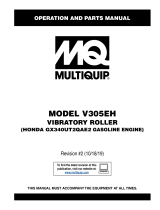
Safety Information RS 800 /...
wc_si000178gb.fm 8
1.1 Operating Safety
Familiarity and proper training are required for the safe operation of the
machine. Machines operated improperly or by untrained personnel
can be hazardous. Read the operating instructions contained in this
manual and the engine manual, and familiarize yourself with the
location and proper use of all controls. Inexperienced operators should
receive instruction from someone familiar with the machine before
being allowed to operate it.
1.1.1 NEVER operate this machine in applications for which it is not
intended.
1.1.2 Do not touch the engine or muffler while the engine is on or
immediately after it has been turned off. These areas get hot and may
cause burns.
1.1.3 Do not use accessories or attachments that are not recommended by
Wacker Neuson. Damage to equipment and injury to the user may
result.
1.1.4 ALWAYS wear protective clothing appropriate to the job site when
operating the machine.
1.1.5 ALWAYS remain aware of moving parts and keep hands, feet, and
loose clothing away from the moving parts of the machine.
1.1.6 Read, understand, and follow procedures in the Operator’s Manual
before attempting to operate the machine.
1.1.7 ALWAYS check that all controls are functioning properly immediately
after start-up! DO NOT operate machine unless all controls operate
correctly.
1.1.8 ALWAYS remain aware of changing positions and movement of other
equipment and personnel on the job site.
1.1.9 ALWAYS remain aware of changing surface conditions and use extra
care when operating over uneven ground, on hills, or over soft or
coarse material. The machine could shift or slide unexpectedly.
1.1.10 ALWAYS use caution when operating near the edges of pits, trenches
or platforms. Check to be sure ground surface is stable enough to
support the weight of the machine and operator and there is no danger
of the machine sliding, falling or tipping.
1.1.11 Always operate machine with all safety devices and guards in place
and in working order. Do not modify or defeat safety devices. Do not
operate machine if any safety devices or guards are missing or
inoperative.
1.1.12 ALWAYS position yourself safely when operating machine in reverse
or on hills. Leave enough space between yourself and the machine so
you will not be placed in a hazardous position should the machine slide
or tip.
WARNING























